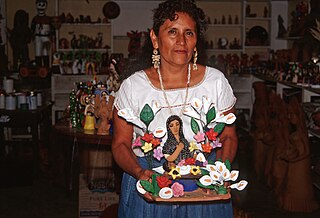Related Research Articles

The Soteno family of Metepec is one of the main families of ceramic artisans specializing in sculptures called Trees of Life which have made the town found in the State of Mexico one of Mexico’s main ceramic centers. The Tree of Life is a complicated colorful sculpture which was developed from the creation of candlesticks. The family’s prominence began with Modesta Fernández Mata, the mother, grandmother and great-grandmother of the Soteno potters today, who began experimenting making more decorative items along with utilitarian ones. The generations after her have learned the craft and improved on it starting as children working with parents and grandparents. The two most notable members of the family are Tiburcio and Oscar, second and third generation respectively, who have won various awards and have their works in collections worldwide.

Guillermo Ríos Alcalá is a Mexican potter, restoration expert and educator from the state of Colima.

Ángel Santos Juárez is a Mexican potter known for his miniatures and decorative work, which has won various awards.

The Aguilar family of Ocotlán de Morelos are from a rural town in the state of Oaxaca, Mexico. This town produced only utilitarian items until Isaura Alcantara Diaz began creating decorative figures with her husband Jesus Aguila Revilla. The couple taught their five daughters who continued innovating their own styles and then teaching the two generations after them. Two of the sisters, Guilliermina and Irene have been named “grand masters” by the Fomento Cultural Banamex, for their figures and sets of figures related to the life and traditions of Oaxaca, as well as Mexican icons such as Frida Kahlo and the Virgin of Guadalupe. The younger generations have made their own adaptations with some attaining their own recognition such as Lorenzo Demetrio García Aguilar and Jose Francisco Garcia Vazquez.

Hilario Alejos Madrigal is a Mexican potter from a small town in the state of Michoacán, known for his “pineapple” ceramic wares. The name comes from the original form which was created by his mother, potter Elisa Madrigal Martinez, who created punch bowls in the shape of pineapples. Alejos Madriga’s variations include bowls, candelabras and more, with the version done in a green glaze be best known. Alejos Madrigal has won awards for his work, which is featured on the cover of large reference book Grandes Maestros del Arte Popular Mexicano by Fomento Cultural Banamex.
Adrián Luis González is a Mexican potter specializes in Trees of Life and other decorative pieces.
María de Jesús Nolasco Elías was a Mexican potter from Ocumicho, Michoacán, a town noted for the creation of colorful ceramic figurines.
Leonarda Estrella Laureano is a Mayo Mexican potter from Capomos, El Fuerte in Sinaloa.

Florentino Jimón Barba is a Mexican potter based in Tonalá, Jalisco.
Cayetano Corona Gaspariano is a Mexican potter from San Pablo del Monte, Tlaxcala, who is the only authenticated producer of Talavera ceramics in the state.
José García Antonio is a Mexican potter from San Antonio Castillo Velasco in the municipality of Ocotlán, Oaxaca, a town noted for its handcrafts. He still has is house and workshop there, located beyond the church behind a tall gate that hides what is inside.

Nicasio Pajarito Gonzalez is a Mexican potter from Tonalá, Jalisco known for his canelo ware.
Cesar Torres Ramírez is a Mexican potter who specialized in the country Talavera pottery tradition. His work has been featured in books such as Cerámica Y Cultura: The Story of Spanish and Mexican Mayólica of the Museum of International Folk Art in New Mexico, in the Grandes Maestros de Arte Popular Mexicano as a “grand master” by the Fomento Cultural Banamex and as one of Mexico's best artisans in a documentary on Canal Once in Mexico.
Jesús Carranza Cortés is a Mexican potter from Tlaquepaque, Jalisco, noted for miniatures he creates in his small workshop there. These pieces are of people such as street vendors, farm workers in traditional attire, lovers, mariachis and more. Most are created in scenes that depict Mexico’s past.
Pedro Ruiz Martínez and Odilia Pineda are husband and wife Mexican potters, who work in Capula, Michoacán. This town is noted for its ceramics distinguished by having its designs painted on with small dots in a technique called “punteaje.”

Alfonso Castillo Orta was a Mexican potter from the ceramics town of Izúcar de Matamoros, Puebla, whose work made the ceramics of this area internationally known. He was particularly known for his trees of life sculptures and received various awards for his work, including the Premio Nacional de Ciencias y Artes in 1996. He taught the craft to his wife and five children who continue to create pieces in his style in the family workshop.
Neftalí Ayungua Suárez was a Mexican potter from Patamban, Michoacán, named a “grand master” of Mexican folk art.
Celso Camacho Quiroz is a fourth-generation Mexican potter who works in Metepec, in the State of Mexico. His specialty is the making of large cooking vessels called “cazuelas,” traditionally used to cook mole and rice, but he also makes a number of other utilitarian and decorative pieces. His work has been recognized with awards such as the Gran Premio de Arte Popular from FONART in 1999 and being named a “grand master” by the Fomento Cultural Banamex in 2003.
Miguel Chan and Roger Juárez are Mexican potters, partners in producing Mayan culture-inspired pottery in Ticul, in the state of Yucatán. Ticul, along with Mama and Maxcanú are traditional pottery centers for the state, where pieces are made using a k´abal, a rudimentary form of pottery wheel. The pieces are decorated using implements that they make themselves from branches, leather, gourds and feathers.
References
- 1 2 3 4 Grandes Maestros del Arte Popular Mexicano. Mexico City: Collección Fomento Cultural Banamex. 2001. p. 137. ISBN 968-5234-03-5.
- ↑ "Collection Online". England: British Museum. Retrieved January 29, 2014.